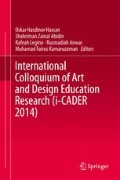Abstract
Raku refers to a low-temperature firing technique which originated from Japan and is admired internationally nowadays for its simple, spontaneous, yet decorative effects through the firing itself or its glaze composition. The problem statement would be from raku firing; it is somehow rather difficult to obtain an identical effect through the same firing along with the same glaze composition; hence, ceramic material tends to crack due to rapid heating and cooling of the fired ware. Furthermore, the after effects of raku firing are often towards a darker shade as brighter shades are infrequently obtained. One of the objectives of this research is to control all aspects of the firing beginning with the timing and ending with an evenly distributed circulation of heat. Another aspect is to overcome the crack defects for the ceramic material by obtaining a glaze composition that will produce a brighter shade effect from raku firing. In this work, a defect-free ceramic product with the identical glaze effect will be produced through a single raku firing.
Access this chapter
Tax calculation will be finalised at checkout
Purchases are for personal use only
References
Pitelka, M. (2005). Handmade culture: Raku potters, patrons and tea practitioners in Japan. Honolulu: University of Hawaii Press.
McGriff, M. (2007). Raku: Tradition and innovations. Muncie: Ball State University.
Anwar, R., Kamarun, H. R., Vermol, V. V., & Hassan, O. H. (2011). Marble dust incorporate in standard local ceramic body as enhancement in sanitary ware products. In IEEE Colloquium on Humanities, Science and Engineering Research, Penang, pp. 355–357.
Branfman, S. (2009). Mastering raku: Making ware, glazes, building kilns, firing (1st ed.). Asheville: A Lark Ceramics Book.
Dassow, S. V. (2011). Barrel, pit and saggar firing: A collection of articles from ceramic monthly, (p. 9). Westerville: The American Ceramic Society.
Perryman, J. (2008). Smoke firing: Contemporary artists and approaches. Philadelphia: University of Pennsylvania Press.
Jones, B. (2009). Raku firing: Advance technique. Westerville: The American Society.
Hessenberg, K. (1994). The complete potter: Sawdust firing, Library of Congress Publication Data (p. 9). Philadelphia: University of Pennsylvania Press.
Henley, D. (2002). Clayworks in art therapy: Plying the sacred circle. London/Philadelphia: Jessica Kingsley Publishers.
Kerr, R., & Wood, N. (2004). Science and civilisation in China: Ceramic technology (Vol. 5, p. 296). Cambridge: Cambridge University Press.
Dewar, R. (2002). Stoneware (p. 34). London: A&C Black Publishers Limited.
Peterson, S., & Peterson, J. (2003). The craft and art of clay: A complete potter’s handbook (4th ed.). London: Laurence King Publishing.
Yahya, M., Anwar, R., Hassan, O. H., & Kamaruzaman, M. F. (2013). Local peat soil as ball clay replacement in earthenware. In IEEE Business Engineering and Industrial Applications Colloquium, Langkawi, pp. 161–164.
Cuff, Y. H. (1996). Ceramic technology for potters and sculptors (p. 121). Philadelphia: University of Pennsylvania Press.
Amber, S. (2008). Ceramic for beginners: Handbuilding (1st ed.). Asheville: Lark Books.
Noordin, S. N. A., Salleh, M. R., Anwar, R., Hassan, O. H., & Kamarun H. R. (2012). Hypothetical framework for luminescence effect as advanced decoration on Labu Sayong. In 2012 IEEE Symposium on Business, Engineering and Industrial Applications (ISBEIA), pp. 398–400.
Acknowledgements
The authors would like to acknowledge the Ministry of Education for the financial support under Research Acculturation Grant Scheme (RAGS) and Universiti Teknologi MARA (UiTM) for the excellent fund scheme. Special thanks to Formgiving Design Research Lab members for their inputs and contribution.
Author information
Authors and Affiliations
Corresponding author
Editor information
Editors and Affiliations
Rights and permissions
Copyright information
© 2015 Springer Science+Business Media Singapore
About this paper
Cite this paper
Ali, A., Jalil, A.R., Salleh, M.R., Anwar, R. (2015). The Exploration Methods of Consistent Raku Firing Glaze Effect Framework. In: Hassan, O., Abidin, S., Legino, R., Anwar, R., Kamaruzaman, M. (eds) International Colloquium of Art and Design Education Research (i-CADER 2014). Springer, Singapore. https://doi.org/10.1007/978-981-287-332-3_17
Download citation
DOI: https://doi.org/10.1007/978-981-287-332-3_17
Publisher Name: Springer, Singapore
Print ISBN: 978-981-287-331-6
Online ISBN: 978-981-287-332-3
eBook Packages: Humanities, Social Sciences and LawEducation (R0)

